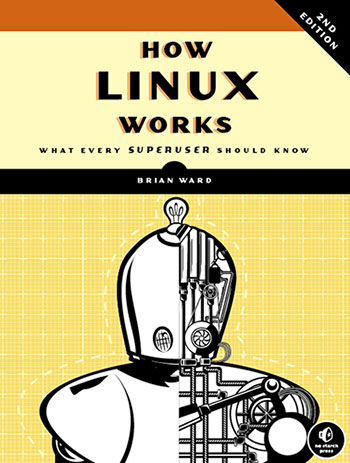![]()
How Linux Works: What Every Superuser Should Know, 2nd EditionBy Brian WardNo Starch PressNovember 21, 2014, 392 pp.US$39.95 Print Book and E-Book (No Starch Press) $26.37 Paperback (Amazon)$31.95 E-Book (No Starch Press) How Linux Works: What Every Superuser Should Know offers an unglamorous view of the Linux operating system. It takes readers behind the graphical user interface into the bowels of command line operations.
This second edition of Brian Ward’s classic Linux reference book is completely revised, and it offers something for every Linux user.
Ward drills down to the technical specifics that developers need — but he also peels back the onion layers gently enough for Linux tinkerers to know what happens when they do stuff with the operating system — and why.
Casual Linux users run a slight risk of getting lost in some of the verbiage. Readers need only basic computer-user knowledge, though, such as how to move around a GUI, and the differences between files, directories and folders.
Two more reader prerequisites include an ability to check additional system documentation and a yearning to play around with a computer.
No Fight Policy
Ward wrote this second edition to feed his passion for helping Linux users learn why and how their computers work. He believes computer users should know how to use the operating system software as intended.
How Linux Works helps to achieve that goal. It provides Linux users with an understanding of the fundamentals.
“You should never have to fight with a computer!” is Ward’s battle cry. How Linux Works is a nonthreatening way to take the frustration out of using a computer.
Game Plan
This book is not organized the way you might expect. It is not a Linux For Dummies type of read that takes a soft approach. Rather, it delves into detailed workings of the Linux architecture in three basic sections.
Ward presents a solid technical view of the Linux OS in the initial chapters. This heavy dose of details goes a long way toward explaining the nuts and bolts that make Linux what it is.
Ward begins with the big picture in Chapter 1. Then he meticulously takes readers behind the scenes. He disassembles that picture layer by layer to reveal its details.
His philosophy is very clear. This is not a user’s guide to navigate the desktop GUI. It is a treatise on all of the assembled components. He takes readers through basic commands and directory hierarchy, devices, and disks and filesystems in Chapters 2 through 4.
Building Momentum
That is a necessary foundation. Ward uses it to reveal to readers how the Linux kernel boots and how the user space starts in the next two chapters.
The author’s intent is not to explain how to install and use a Linux distribution. Instead, Ward delves into why Linux works as it does and how to handle its complexities.
For example, Chapter 7 unwraps the mysteries of system configuration. The reader peers into logging, system time, batch jobs and users organizations. Chapter 8 gives readers a closer look at the processes of the OS and utilizing resources.
Moving Beyond
At this point, Ward has exposed the platform under the hood. This is a midpoint from which he embarks on understanding the network and its configuration. He follows those details with a hefty chapter on network applications and services.
Chapter 11 shifts to the third part of the Linux picture. This is where Ward’s approach turns more toward “how” than “what.”
For example, Ward presents an introduction to shell scripts. Then he follows up in Chapter 12 by showing users how to move files across the network.
Changing View
Ward provides a different perspective on the role user environments have in making the Linux operating system work in Chapter 13. He adds to this view in the next chapter by presenting a wrap-up of the Linux desktop.
Much of this book does for Linux users what a mechanic’s shop book does for automotive enthusiasts. Ward tells Linux users why Linux performs as it does. Readers then can feel empowered to use Linux more masterfully.
The final three chapters push this point even further. The reader gets a close up look at development tools. Even better, the book ends with an introduction to compiling software from C Source Code and building upon the basics.
About the Author
Brian Ward has been working with Linux since 1993. He began by scraping together enough pennies for a secondhand 386 computer.
Ward has a Ph.D. in computer science from the University of Chicago. He now works in San Francisco as a consultant and instructor.
In addition to How Linux Works, Ward has authored The Linux Kernel-HOWTO, The Book of VMware and The Linux Problem Solver.
Bottom Line
Readers with a more technical background will find the author’s approach very effective. Those who do not can follow along and just skip over the stuffy parts.
Either way, this book goes a long way toward furthering your understanding of how Linux works. If you are interested in Linux, How Linux Works: What Every Superuser Should Know is a must-read title.





















































